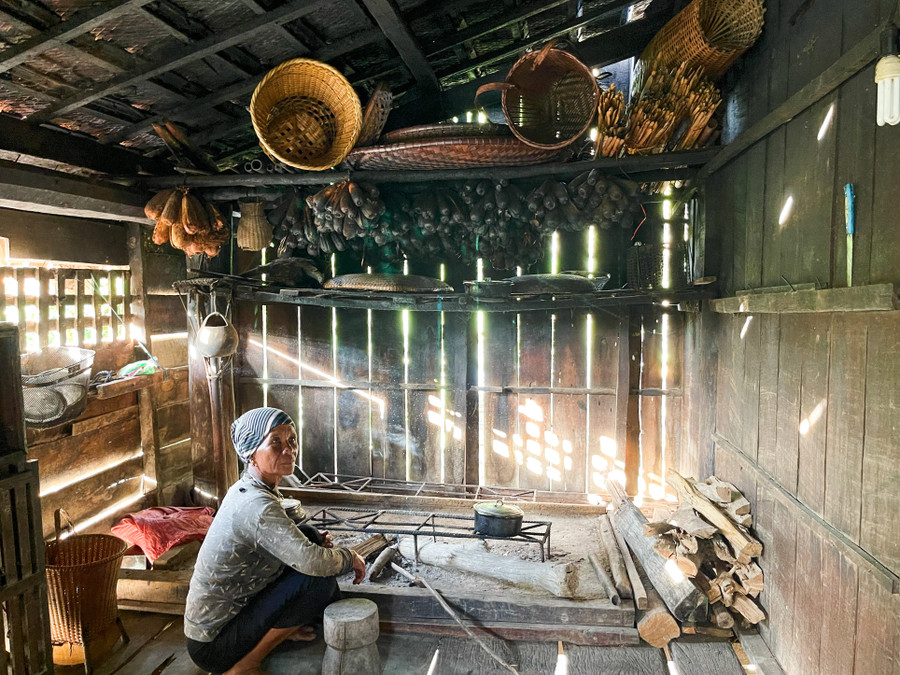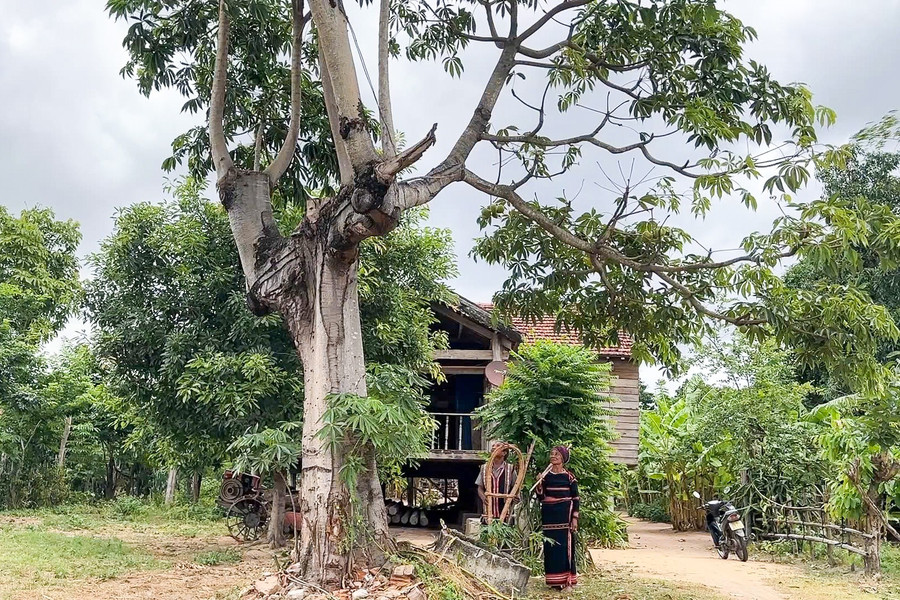The afternoon sun shines through the ventilation window deep into Ma Hoa’s kitchen, “catching” the wisps of blue smoke that light up the entire kitchen. For the Jrai, the kitchen is not only used for cooking, but also contains a treasure trove of life experiences and the spiritual world .

On the kitchen shelf, dyed black with soot, were all kinds of seeds for the next season, along with trays, winnowing baskets, and baskets… kept on top to prevent termites. Among the commonly used objects, the village elder Ma Hoa carefully took down a buffalo head dried by the smoke from the kitchen, a buffalo-tying ring for the gods (Krotonr bong kpao) and a long rattan rope rolled into a ring.
He seemed to be lost in memories when holding in his hands the "sacred objects" of the buffalo stabbing ceremony 20 years ago. Ma Hoa recalled: The sacrificial buffalo was raised by the family for 3 years, weighing more than 400 kg. The buffalo's head was then kept on the kitchen rack. The buffalo's tying ring was woven by his brother-in-law in the forest to find old rattan and took 3 days and nights to complete. The long rattan rope was used to thread through the buffalo's nose and pulled from the yard into the kitchen - like a rope connecting the gods to the family's hearth.

The Jrai believe that the kitchen is the most sacred space in the house. By doing so, the fire of life will never go out, the stove will always be warm so that the homeowner can have a prosperous and peaceful life.
If the buffalo stabbing ceremony is held at home to thank the gods and pray for health, the ceremony is held in the field to thank the Water God. It is one of the important rituals of the Jrai people because they consider water to be the source of life.
The Ma Hoa family's buffalo stabbing ceremony is still remembered by many people because both times, the villagers attended in large numbers with hundreds of jars of rice wine brought to contribute to the fun. Therefore, the buffalo stabbing ceremony is also considered an occasion to unite the community, and individual joy becomes the common joy of the village.

Not only organizing buffalo stabbing, Ma Hoa’s family also organizes many traditional festivals and ceremonies of the Jrai people. Traces of those festivals are not only in the stories. Outside the kitchen, right above the smoke vents, there are hundreds of buffalo and cow jawbones lined up - evidence of the closed festivals such as grave-leaving ceremonies, longevity celebrations, new rice eating...
Ma Hoa's wife, Mrs. Ksor H'Dliap, added: One year, just for her mother's grave-leaving ceremony, relatives contributed up to 57 buffaloes, cows, and pigs. She kept them all, storing them around the kitchen. "The kitchen is the most important place in the house. I keep them so that in the future, my children and grandchildren will know how their grandparents' cultural life took place so that they will not forget their roots and cultural traditions. The Jrai follow matriarchy, women have to keep the fire warm, keep the jars, keep the family's memories, and make sure the fire never goes out," she said.
If Mrs. H'Dliap is the one who keeps the warm fire in the family, Ma Hoa is trusted by the village to keep the spiritual "fire" of the community.
He is a village elder, a Party member with nearly 40 years of Party membership, and has held many positions. The badges, medals, certificates of merit, and awards hanging all over his house are proof that, in every position, he has made positive contributions. He is trusted by the villagers for his skillful mobilization, determination to eliminate bad customs, and pioneering economic development.
In the long house, which still preserves a collection of precious jars and ancient gongs, Ma Hoa slowly said: "Culture must be preserved, but festivals should not be organized in a grand and expensive manner to focus on economic development." The proof is that after his mother's grave-leaving ceremony with the largest number of buffaloes and cows in the Ia Mlah riverside area, he had to hold a village meeting to advocate for the policy of saving.

“In the past 20 years, I have only stabbed buffaloes twice, associated with the most important events in the family. It was to unite the community and maintain traditional culture. But now that ceremony is gradually fading away. I hope that the next generation, when seeing the sacred objects kept under the roof of this long house, will continue to preserve the cultural heritage of their ancestors,” he said.
The kapok tree in front of the long house - the place where buffaloes were tied for sacrifices years ago - now spreads its shade, its roots deep into the ground. Each season the kapok flowers bloom, recalling the many jubilant festivals that have left their mark in the village's memory. In that space, the evidence of the festival still quietly reminds people of a unique and magical cultural region on the majestic plateau.
Source: https://baogialai.com.vn/chuyen-quanh-gian-bep-nha-ma-hoa-post566319.html


![[Photo] General Secretary To Lam, Secretary of the Central Military Commission attends the 12th Party Congress of the Army](https://vphoto.vietnam.vn/thumb/1200x675/vietnam/resource/IMAGE/2025/9/30/9b63aaa37ddb472ead84e3870a8ae825)

![[Photo] General Secretary To Lam receives US Ambassador to Vietnam Marc Knapper](https://vphoto.vietnam.vn/thumb/1200x675/vietnam/resource/IMAGE/2025/9/29/c8fd0761aa184da7814aee57d87c49b3)

![[Photo] The 1st Congress of Phu Tho Provincial Party Committee, term 2025-2030](https://vphoto.vietnam.vn/thumb/1200x675/vietnam/resource/IMAGE/2025/9/30/1507da06216649bba8a1ce6251816820)
![[Photo] Solemn opening of the 12th Military Party Congress for the 2025-2030 term](https://vphoto.vietnam.vn/thumb/1200x675/vietnam/resource/IMAGE/2025/9/30/2cd383b3130d41a1a4b5ace0d5eb989d)






























![[Photo] General Secretary To Lam attends the ceremony to celebrate the 80th anniversary of the post and telecommunications sector and the 66th anniversary of the science and technology sector.](https://vphoto.vietnam.vn/thumb/1200x675/vietnam/resource/IMAGE/2025/9/29/8e86b39b8fe44121a2b14a031f4cef46)

































































Comment (0)